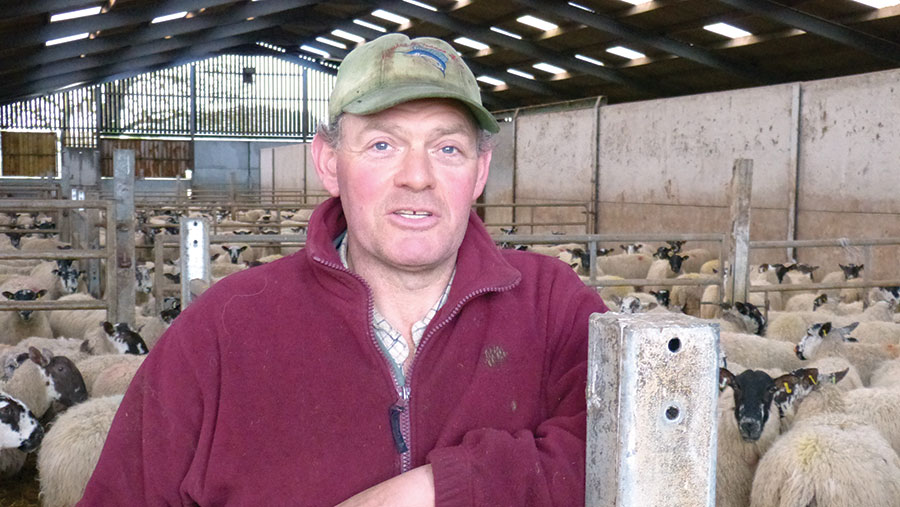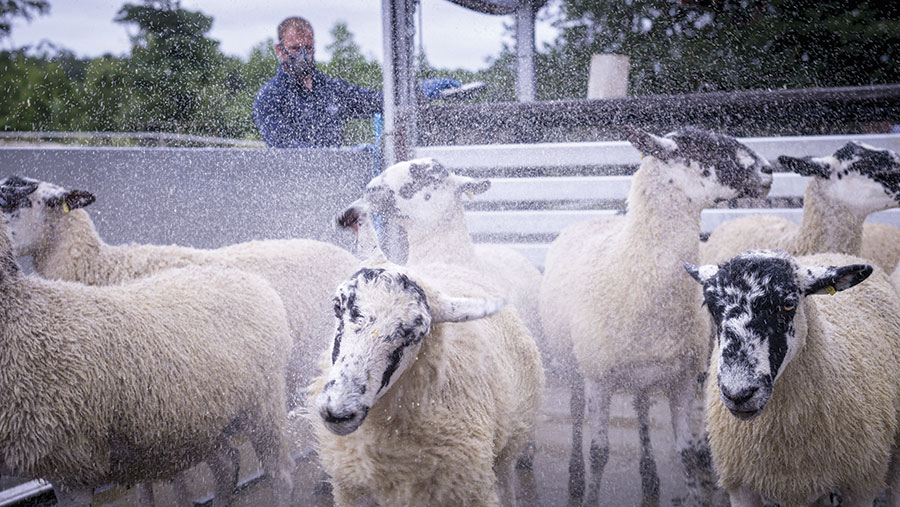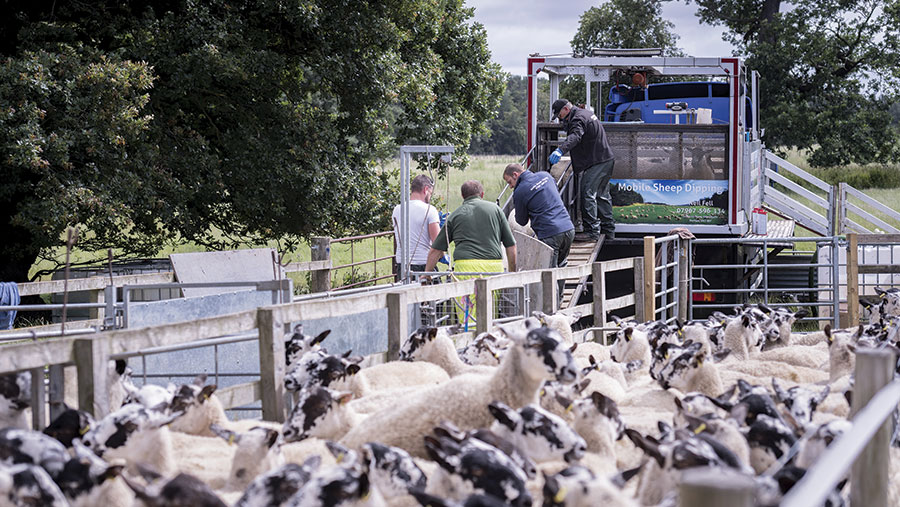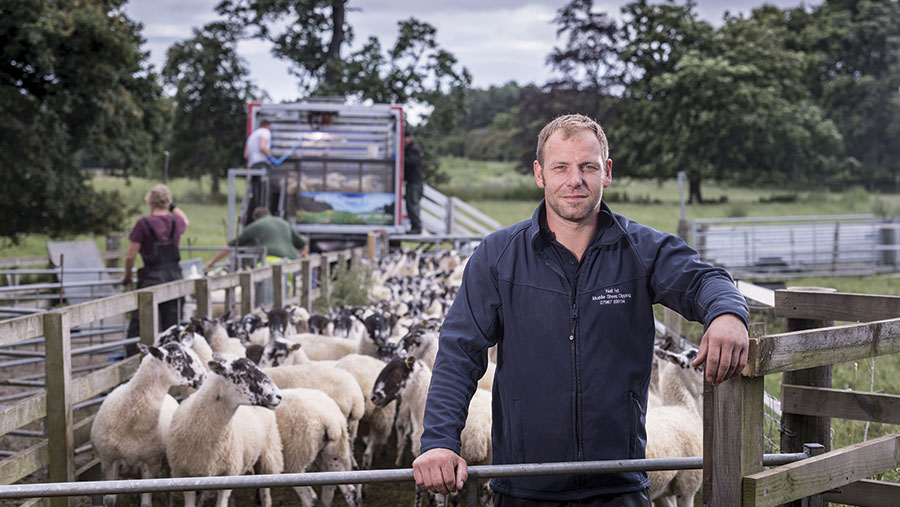Sheep farmer sees four clear benefits of plunge-dipping
Safe and efficient plunge-dipping is a key part of a thorough flock health plan for Northumberland commercial lamb producer Selby North-Lewis.
Always a big believer in plunge-dipping, Mr North-Lewis’ flock, based at Colwell, Hexham, has been dipped by Neil Fell Sheep Dipping (NFSD) – 2019 Farmers Weekly Innovator of the Year – for about 14 years.
“I used to dip them myself and rent a mobile dipping trailer for three or four days,” explains Mr North-Lewis. “I was worried about lice at the time.”
See also: Video: Business flourishes with bespoke sheep-dipping crate
Now all breeding sheep are dipped annually in an automatic mobile dipping truck, and last year, all lambs were dipped too – 6,500-head in total.
Mr North-Lewis says he has seen five clear benefits of plunge dipping this way.

Selby North-Lewis © Michael Priestley
Farm facts
- 1,000ha, of which 121ha in arable
- 1,800 North Country Mules and 500 Highland-cross gimmers
- Uses Abermax or Charolais cross Beltex terminal sires
- Aims to produce R3L at 19-20kg deadweight
- 323ha on farm business tenancy (FBT) to 2035 and rest on annual FBTs
- Sells winter wheat and barley and spring oats to buy in sheep feed
1. Health and safety
The dipping crate is operated by three contract dippers all wearing personal protective equipment (PPE). Sheep move through pens, up a race and through the dipping trailer.
Dipping typically takes place two weeks before tupping kicks off, when ewes are given their pre-tupping check at the start of October.
Throughout this time, Mr North-Lewis doesn’t go near the dip. He collects mobs of sheep on a quad bike and takes them away once the sheep have dried.
This means all necessary precautions are taken, explains Mr North-Lewis.
NFSD then disposes of the used sheep dip safely, storing it in plastic tanks before the council remove it.

© Jim Varney
2. Labour
The crate dips in excess of 300 sheep/hour, which is more than double the rate of a standard mobile dipping trailer.
This means breeding sheep can all be processed by Mr North-Lewis and the contractors in a single day, despite the farm only employing a part-time labourer.
A farmhand comes to work two to three days a week, and extra lambing workers are needed in the shed in March and April.
The distance sheep are moved is minimised because the dipping trailer travels between the two main farms of the business, starting at the home farm – South Farm – and then Park End five miles away.
3. Biosecurity
A vitally important feature of flock health and productivity for Mr North-Lewis is biosecurity, which he explains can be difficult to achieve as a tenant farmer with lots of neighbours.
However, dipping plays an important role in controlling sheep scab, which has become a thorny issue in the industry because of its ability to spread. It is not a notifiable disease in most of the UK, but was made a notifiable disease in Scotland in 2010.
While Mr North-Lewis has no reason to worry about sheep farms in the area, he sees dipping as another tool to manage all ectoparasites.

© Jim Varney
With the entire farming business on rented land, the flock has 11 different neighbours (all with sheep) and four landlords.
This includes 242ha of upland summering ground grazed by dry hoggets as part of a moorland conservation scheme 25 miles away near Alston.
Hoggets are shorn in May before leaving the farm for the summer and are dipped when they return in early autumn.
In addition to dipping, fencing is also a key investment, which has been improved in recent years at a cost of about £6,000/year to minimise cross-border contact.
The farm also recently moved to a self-replacing system, to further enhance flock biosecurity.
North of England Mules have been bought privately from a trusted and reputed breeder. However, the farm is now looking to breed replacement from Innovis sires (Aberfield and Highlander).
4. Profitability
The flock has been financially analysed and benchmarked for many years by Elliot Taylor, who previously worked at the Newcastle University and is now a partner in George F White, a firm of land, property and business consultants.
Mr Taylor’s mantra is to consider the cumulative effect of marginal gains to improve business efficiency and balance cost control and flock output.
The Mules achieved a gross margin of £55.89 a ewe last year, with total variable costs of £42.36 a ewe, and £11.50 a ewe spent on concentrates and £13.67 on forage.
The other cross-bred sheep achieved a gross margin of £54.09 a ewe, with £8.47 spent on concentrates and £10.93 on forage.
A key part of returning a healthy gross margin every year is good productivity out of prolific cross-bred ewes, explains Mr North Lewis.
The farm typically sells 1.6 lambs per ewe tupped, with a top figure of 1.68.
Scanning of at least 180% is needed to get the volume of lambs, and part of this is a good flush in late summer after dipping, explains Mr North-Lewis
“I’ve always liked the fact sheep bounced after being dipped,” he explains. “The ewes seem to flush better and look like better sheep. It helps the lambs finish too.
“I think it’s worth another 2-3% on the lambing percentage. Across an 1,800-ewe flock, that could be worth 42 lambs sold with mortality factored in, which at £75 a lamb is worth over £3,000, so it’s safely paid for the cost of dipping at about £1 a head.”
The cost of the dipping also stacks up against other options, explains Mr North-Lewis.
Costing a cypermethrin pour-on at 15p a dose for lambs and 30p for ewes, Mr North-Lewis says that at two doses a year, this treatment could cost about £1,080 across 1,800 ewes alone and this only covers flies and ticks.
Meanwhile, injectable moxidectin comes with resistance issues, explains Mr North-Lewis.
Sheep system
- Lambing Indoor lambing for three cycles (six weeks) with rams changed each cycle from mid-March. All prime lambs sold by mid-October.
- Ration Total mixed ration fed to ewes for six weeks before lambing, feeding grass silage (22mm chop length) from ag bag and 18% ewe nuts with glucose to help colostrum production. Nuts fed at 0.25kg a head a day six weeks before lambing, 0.5kg a head a day four weeks before lambing and 0.75 a head a day two weeks before lambing for twins, with triplets and singles adjusted accordingly.
- Vaccinations Clostridial vaccination booster programme, and foot-rot and enzootic abortion vaccinations. Vet and med costs were £7 a ewe for the Mules and £8 for the other cross-breds.
- Antibiotics Oral dosing at lambing kept to a minimum and used as a last resort. Antibiotics used to treat first foot-rot case. Animal is given one chance and gets marked
Dipping facts

Neill Fell, who started mobile dipping service Neil Fell Sheep Dipping and Innovative Farmer of the Year 2019 © Jim Varney
- Diazinon-based dip – 60% diazinon
- Licensed for the prevention and treatment of blowfly strike, lice, ticks, scab and keds
- 49-day meat withdrawal
- Costs £1.20 a head for up to 1,500, £1 a head for 2,000-2,500 and 90p for more than 2,500 head
About Farmers Weekly Awards 2020
 The Farmers Weekly 2020 Farm Innovator of the Year Award is sponsored by Co-op.
The Farmers Weekly 2020 Farm Innovator of the Year Award is sponsored by Co-op.
Join Farmers Weekly in celebrating the farming industry and recognising the hard work of UK farmers and enter the awards today.
Alternatively, nominate a deserving individual for an award.
For more information about the Farmers Weekly Awards 2020, pay a visit to the official website.
